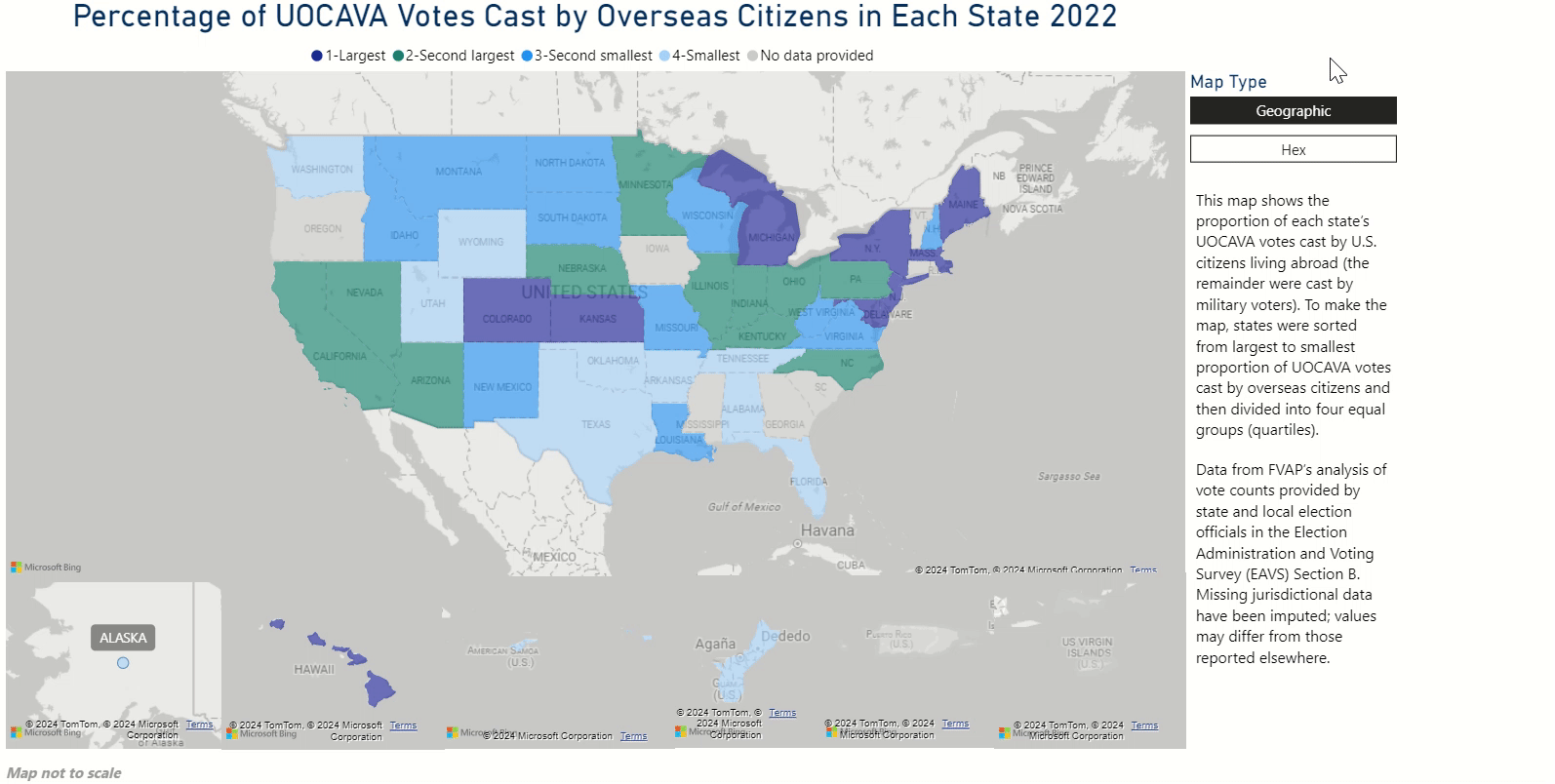UOCAVA Voting in U.S. States
U.S. elections are managed by the 50 states, U.S. territories (American Samoa, Guam, Puerto Rico and the U.S. Virgin Islands), and the District of Columbia. All must implement provisions of the Uniformed and Overseas Citizens Absentee Voting Act (UOCAVA), as amended by the Military and Overseas Voter Empowerment (MOVE) Act, for voters who are members of the Uniformed Services, their eligible familymembers, and U.S. citizens residing abroad. These requirements include:
- Accepting the Federal Post Card Application (FPCA) for simultaneous voter registration and absentee ballot request;
- Transmitting ballots to voters at least 45 days before federal elections;
- Offering voters the option of receiving their ballot electronically (states can choose to offer email, fax, or online portal); and
- Accepting the Federal Write-in Absentee Ballot (FWAB) as a backup ballot for all federal elections.
UOCAVA Voters in Each State
Other aspects of the voting process — such as deadlines for voter registration and ballot request, as well as methods permitted for voters to return their absentee ballots — vary by state.
Some states and territories have larger proportions of UOCAVA voters than others — mostly reflective of population centers and the top sources of military recruitment and duty stations.
FVAP partners with the Election Assistance Commission to conduct the Election Administration and Voting Survey (EAVS) sent to all 6000+ state and local election jurisdictions following each federal election. Questions about UOCAVA ballots are in EAVS Section B. To minimize undercounting, FVAP replaces missing jurisdictional data with data imputed from the responses of jurisdictions of similar size. The values reported here are obtained from the imputed data and may differ from those reported elsewhere. For methodological details, see FVAP's PEVS-Quant LEO Technical Reports.
The maps show the proportions of UOCAVA voters in each state in recent General Election years. The hexagonal maps make it easier to see regional trends by making all states equal size.

UOCAVA Votes Cast by Military
Some states have larger proportions of their UOCAVA votes cast by military members and their families.These states typically demonstrate larger population centers or larger percentages of citizens choosing to live abroad. FVAP's mputed data from EAVS Section B provide the breakdown of UOCAVA ballots cast by military versus overseas voters.
UOCAVA Votes Cast by Overseas Citizens
Some states have larger proportions of their UOCAVA votes cast by citizens living abroad than by military members and their families. They include states without high numbers of military voters or with larger percentages of citizens choosing to live abroad. Imputed data from EAVS Section B provide the breakdown of UOCAVA ballots cast by military versus overseas voters.

State UOCAVA Policies
State policies affect the obstacles faced by UOCAVA voters. Each U.S. state or territory sets its own deadlines for voter registration and ballot return. While all must offer UOCAVA voters an option for receiving their blank ballot electronically, each state can choose which electronic method(s) to offer (e.g., email, fax, or online portal). FVAP's annual Reports to Congress include the percent of ballots that states send to voters via an electronic method for each general election.
States also choose the methods UOCAVA voters can use to submit their applications to register and request their ballot. Most offer some form of electronic voter registration/ballot request submission method, though a few states require postal mail.
For ballot return, postal mail remains the only universally accepted method and the most commonly used. States can choose whether to allow UOCAVA voters to return completed ballots electronically, and more and more offer this option. While a few states have developed online portals or apps, fax and email are the most common electronic options for ballot return. Some states restrict electronic return to military who are deployed and overseas voters who experience special circumstances preventing timely mail return. Some states are experimenting with electronic return using other online technologies.
The maps show the options available in each state as of the date published. Check a state or territory's election website for the most current policies affecting UOCAVA voters.

Additional Research and Reports
FVAP's annual Post-Election Reports to Congress and technical reports on the biennial Post-Election Voting Survey of State Election Officials and quantitative data collected from local officials provide metrics on states' UOCAVA voters. Research Notes explore the impact of specific aspects of state policies and procedures on UOCAVA voting.
| Name | Election Year | Document Type |
|---|---|---|
| 2022 Post-Election Report to Congress | 2022 | RTC |
| ESB Reseach Note on Data Standardization in the 2020 Election | 2020 | Research Note |
| ESB Reseach Note on Data Standardization in the 2020 Election Summary | 2020 | Research Note |
| State Election Officials Post-Election Voting Survey: Technical Report 2020 | 2020 | Report |
| 2020 Post-Election Report to Congress | 2020 | RTC |
| Assessing State UOCAVA Web Pages | 2019 | Research Note |
| 2018 | RTC | |
|
State Election Officials Post-Election Voting Survey: Technical Report 2018 |
2018 | Report |
|
Quant Local Election Officials Post-Election Voting Survey: Technical Report 2018 |
2018 | Report |
| 2016 | Research Note | |
| 2016 | Research Note Summary | |
| 2016 | RTC | |
|
State Election Officials Post-Election Voting Survey: Technical Report 2016 |
2016 | Report |
|
Quant Local Election Officials Post-Election Voting Survey: Technical Report 2016 |
2016 | Report |
| 2014 | RTC | |
|
Quant Local Election Officials Post-Election Voting Survey: Technical Report 2014 |
2014 | Report |
| 2012 | RTC |





